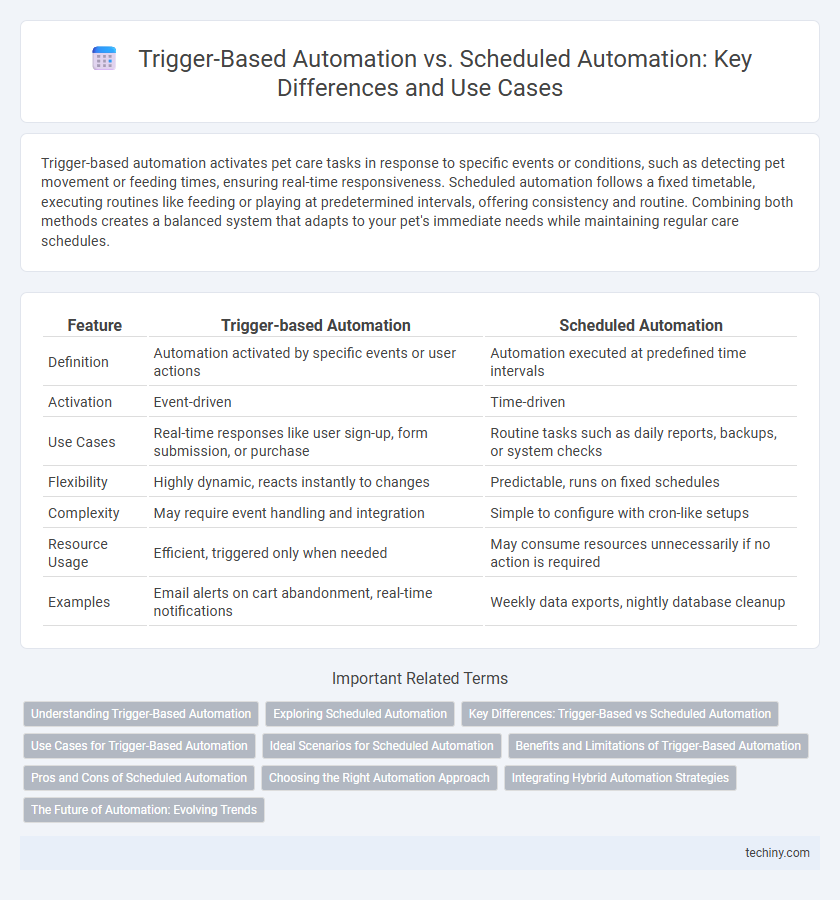Trigger-based automation activates pet care tasks in response to specific events or conditions, such as detecting pet movement or feeding times, ensuring real-time responsiveness. Scheduled automation follows a fixed timetable, executing routines like feeding or playing at predetermined intervals, offering consistency and routine. Combining both methods creates a balanced system that adapts to your pet's immediate needs while maintaining regular care schedules.
Table of Comparison
| Feature | Trigger-based Automation | Scheduled Automation |
|---|---|---|
| Definition | Automation activated by specific events or user actions | Automation executed at predefined time intervals |
| Activation | Event-driven | Time-driven |
| Use Cases | Real-time responses like user sign-up, form submission, or purchase | Routine tasks such as daily reports, backups, or system checks |
| Flexibility | Highly dynamic, reacts instantly to changes | Predictable, runs on fixed schedules |
| Complexity | May require event handling and integration | Simple to configure with cron-like setups |
| Resource Usage | Efficient, triggered only when needed | May consume resources unnecessarily if no action is required |
| Examples | Email alerts on cart abandonment, real-time notifications | Weekly data exports, nightly database cleanup |
Understanding Trigger-Based Automation
Trigger-based automation activates specific workflows immediately when predefined events occur, ensuring real-time responsiveness and increased operational efficiency. It relies on conditions such as user actions, system changes, or sensor inputs to initiate tasks without delay, minimizing manual intervention. This approach is essential for dynamic environments where timely reactions to data or events drive productivity and enhance user experience.
Exploring Scheduled Automation
Scheduled automation executes predefined tasks at specific times or intervals, ensuring consistent and timely operations without manual intervention. This method optimizes resource allocation by automating routine processes such as data backups, report generation, and system maintenance based on fixed schedules. Enterprises benefit from predictable workflow management and enhanced operational efficiency with scheduled automation.
Key Differences: Trigger-Based vs Scheduled Automation
Trigger-based automation executes tasks instantly in response to specific events or conditions, enabling real-time process adjustments and increased responsiveness. Scheduled automation runs predefined workflows at set intervals or times, optimizing routine operations and resource allocation without manual intervention. Key differences lie in timing and initiation: trigger-based automates actions based on dynamic inputs, while scheduled automation relies on fixed schedules for consistent execution.
Use Cases for Trigger-Based Automation
Trigger-based automation excels in real-time scenarios such as instant customer support responses, dynamic inventory updates, and personalized marketing campaigns triggered by user actions. These automations respond immediately to specific events like form submissions, website behavior, or sensor inputs, ensuring timely and relevant workflows. Their primary use cases include enhancing customer engagement, optimizing operational efficiency, and enabling proactive issue resolution.
Ideal Scenarios for Scheduled Automation
Scheduled automation is ideal for recurring tasks that require execution at consistent intervals, such as daily data backups, system updates, and report generation. It ensures reliable performance without manual intervention, optimizing resource allocation during off-peak hours. Businesses leveraging scheduled automation benefit from enhanced operational efficiency and reduced risk of human error in time-sensitive processes.
Benefits and Limitations of Trigger-Based Automation
Trigger-based automation enables immediate responses to specific events, enhancing real-time efficiency and reducing manual intervention. It benefits workflows by ensuring actions occur precisely when needed, minimizing delays and errors. Limitations include dependency on accurate event detection and potential complexity in setting up appropriate triggers for dynamic environments.
Pros and Cons of Scheduled Automation
Scheduled automation enables processes to run at predetermined times, ensuring consistent task execution without manual intervention. Its major advantage lies in predictability and efficient resource allocation, though it may lead to inefficiencies if tasks do not require regular execution or if timing doesn't align with real-time needs. Scheduled automation lacks the responsiveness of trigger-based systems, potentially causing delays in action when immediate responses are critical.
Choosing the Right Automation Approach
Trigger-based automation responds instantly to specific events or conditions, making it ideal for dynamic environments requiring real-time actions such as fraud detection or customer notifications. Scheduled automation executes tasks at predetermined times or intervals, offering reliability for routine processes like data backups or report generation. Selecting the right automation approach depends on factors like the need for immediacy, system scalability, and the nature of the workflow being optimized.
Integrating Hybrid Automation Strategies
Trigger-based automation activates workflows in response to specific events or conditions, enabling real-time responsiveness and precise task execution. Scheduled automation executes predefined tasks at set intervals, ensuring consistent operations and systematic maintenance. Integrating hybrid automation strategies combines event-driven triggers with time-based schedules, optimizing efficiency, reducing latency, and enhancing operational flexibility across complex systems.
The Future of Automation: Evolving Trends
Trigger-based automation leverages real-time data to initiate actions instantly when specific conditions are met, enhancing responsiveness and operational efficiency. Scheduled automation executes predefined tasks at set intervals, ensuring routine processes remain consistent and reliable. Emerging trends indicate a shift toward intelligent hybrid systems that combine the precision of scheduled automation with the adaptability of trigger-based automation, driven by advancements in AI and machine learning algorithms.
Trigger-based Automation vs Scheduled Automation Infographic

 techiny.com
techiny.com